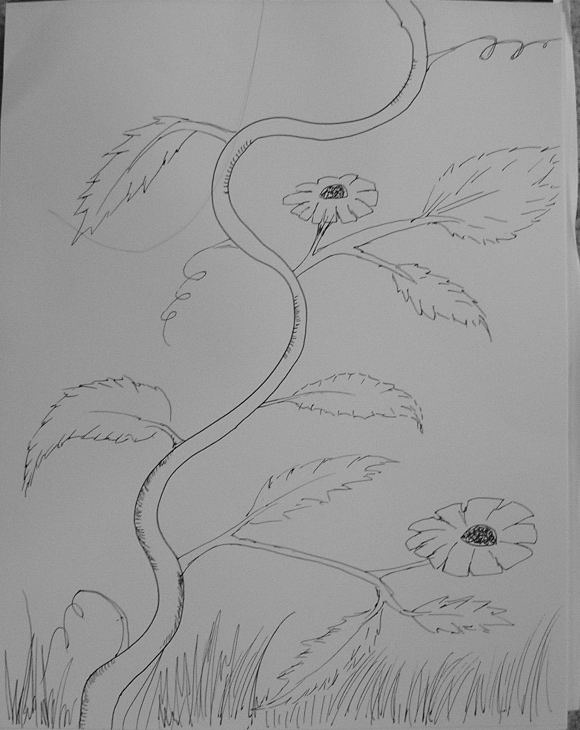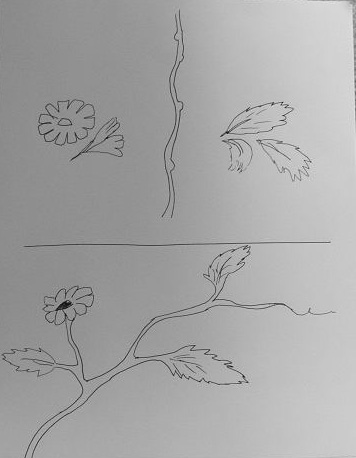The following drawings and written documentation are two forms of representation that when used together develop a dynamic conversation that expands the "thinking" of the artist. This is the work of a graduate student previously enrolled in Level 1: Online.
Color key for text:
1. Please read the black first as this is the artist's initial verbal representation of her drawing.
2. The blue marked by "jb:" is a record of my responses to the artist
3. The green text marked "n:" is her response to me, which led her to do some additional drawing.

Representation of the Child, Teacher and Classroom
When I thought of how I could represent these three concepts, I quickly
thought of their interrelatedness. I thought of the way children, teachers
and the classrooms are connected and the idea of a flowering vine came
to mind. I decided to use India ink and a fountain pen to draw as I had
never done that before. It was a learning experience to learn how to draw
fine lines with a pen and I enjoyed it.
jb: I like the way the vine lets us see the interrelatedness
that you explain as significant.
In this graphic, I see the stem of the vine as the teacher. The teacher
provides support for the children in an unobtrusive way, not calling attention
to herself but adding strength to the children. I saw the children as
the leaves and flowers of the vine. The vine carries water from the soil
to the leaves. If the vine is damaged, the leaves and flowers might not
flourish. The teacher carries something important to the children and
if the teacher is overworked or unsupported, the children won't get as
much as they might need. I thought of the importance of teachers taking
care of themselves in order to be strong and available to children.
jb: It is very interesting how the flowers and
leaves become children of diverse natures. It is an important lesson in
not categorizing that you incorporate in this image. Imagine how we all
"think" of leaves as one general category and flowers as another
and yet here you define them as individualized. Nice.
There is no clear separation between the leaves and vine. When I looked
at a vine outside my house, I saw no clear line or marker that showed
where the leaves began and the vine ended.
When I look at your picture I see lines that do separate the leaves from
the vine stem. I understand something in your writing that I don't see
in the drawing and I wonder if you can transform your drawing in some
way into an image where the separation doesn't exist?
jb: I know it may sound picky to you and it doesn't
mean that I don't appreciate your drawing very much, because I do! Instead
I am using this a learning experience. OK?
I didn't even realize I did that! I will go back and redraw this. I wonder
why I drew lines to separate it.
I see the teacher as also connected strongly to the children with no clear
separation between them. The teacher is a co-learner and co-researcher
so she is not separate from them in that way. There are differences but
also a very important connection in which she is a partner in their learning.
jb: I wonder how you would picture the "process"
of co-learning? I think your picture shows the team of co-learners - what
do you think when I ask about an image to illustrate the learning process?
Is there a way to transform this image to incorporate that idea more fully
into it so we can "see" it?
n: (response to jb) I attached an image I drew of
“co-learning”. I drew the flowers and leaves cut off the vine,
lying separate. Then I drew them all put together on the vine. It symbolizes
that we cannot learn in isolation but must be joined together.
The vine has tendrils that come off of it and they help the vine find
support by attaching onto fences or trees. I see the teacher as always
reaching out for support from colleagues, parents and community members.
The teacher is always open to a new connection to strengthen her program.
jb: Again, another transformation could possibly
occur? Can you show me how the tendrils attach to supports and "what"
the supports are?
n: (response to jb) I have added to the picture to
show the tendrils attaching to a fence symbolizing the supports. For me,
personally in my program, my supports are my two best friends and colleagues
in teaching, the parents in the school, a professor at Michigan State
University, a local artist, the director of the MSU Community music school
and other program staff. See “support” image.
The children are represented by the flowers and leaves. They are all different.
Some leaves are curled over and some are more spiky or straight. Some
are more showy, like the flowers. They are all part of the vine and all
essential to the health of the plant. Children are all different as well.
Leaves receive the sun and cause the photosynthesis which feeds the vine.
In the same way, the children are fed by their learning which in turn
feeds the teacher as she observes and participates in their learning.
The vine would die without leaves. The teacher would be nothing without
the food the children give to her through their experiences and learning.
jb: Can you think about describing the photosynthesis
process you are describing in words? This is where using symbols can really
become a language with verbs that help us to see beyond the "static"
image of perceptual understanding.
n: (response to jb) This is a tough one. I see the
"photosynthesis" process as the learning process. For the children,
they receive nourishment from the richness of materials and the carefully
planned environment. They also hear teachers asking open ended questions
and guiding their experiences. These nourishments are physically converted
in the children's brains to learned knowledge and a disposition towards
learning - an interest is cultivated in them and it grows. The teacher
is nourished by observing and participating in their learning and it increases
her interest in providing more nourishment for them. I drew a new image
to go with this – see “Photosynthesis”. I hope this makes
sense!
Personally, when I see a child learning and enjoying it, I am renewed
in my love for teaching. Today, I sat with a boy at school who had not
used pencil and paper at all last year. He has suddenly become interested
and it was wonderful sitting with him and reflecting back to him about
his drawings. He was drawing trains with sun, clouds, moon and stars above
them because the trains traveled all around the world, day and night.
I also thought of the sun and how it helps the vine and its leaves and
flowers to grow. It is completely separate from the vine but it is essential
to its health. Maybe the community and parents are like the sun. They
also offer essential life giving help to the school. They are intimately
connected to the life of the school. The sun sometimes is hidden or the
clouds cover it. Even though they are not always physically present, the
influence of the community and the parents is important.
jb: Again, think of marks as verbs - action images
- to visually describe what you are thinking about the sun's influence
on the vine.
n: (response to jb) As the sun shines on the vine,
it creates a stored food in the plant that the plant draws on for food.
This stored food sustains the plant when there are cloudy days. The food
is created in the leaves and is used by the whole plant, vine and roots.
The plant is reaching up toward the sun’s rays. I added the sun and
its rays in the drawing.
The influence of parents and community is similar. Their words of encouragement,
their acts of help (weeding the garden, painting the walls) and their
physical presence in the school act as food for the school. When times
are hard, this "food" has been stored and can be called upon
for strength. For example, our school secretary was just laid off and
she was the absolute perfect secretary for the job. I have been heartbroken.
But today at school, the parents were there and began offering to assume
tasks she usually did and some even just assumed parts of her job today.
A professor dropped in and her presence reminded me that I was not in
this alone.
The classroom is the earth from which the vine grows. The earth must be fertile and watered so the vine can grow. The classroom environment is essential to the growing of children. It must have certain components in order for the teacher (the vine) to grow. Each vine grows best in different conditions. Some vines need more water than others, some need less. Each teacher grows in different conditions. Some need more feedback than others. Some need more materials or financial resources. The vine needs just the right place to grow. If it doesn't get what it needs, it might still grow but it might be stunted or weak. If teachers don't get what they need, they might still be able to work but over time, they might be burnt out or tired.
jb: I really wanna see your "earth"
- your classroom!! An idea from my sketchbook practice. When I have an
image that I want to add to and I don't have room I just glue it onto
another larger drawing surface. As a professional artist I use archival
glue so that the drawing will last and, my inclination with archival quality
often carries over to my work with children. Just a thought.
n: (response to jb) See the “earth” image.
I added the richness of the earth to symbolize the richness of the environment.
There are worms aerating the soil, bugs, rocks, and a rabbit in a hole.
I added elements of history such as an old key and tin can. The environment
has life, history, solid rocks and rich earth.

This is my image I drew for co-learning

This is the image with a fence rail added for "support"

This is the image to show how photosynthesis works. It shows the sun shining on the leaves to make food which travels down the vine to the roots.

This is the last image in which I show the earth under the vine and all that is under the earth. I added the richness of the earth to symbolize the richness of the environment. There are worms aerating the soil, bugs, rocks, and a rabbit in a hole. I added elements of history such as an old key and tin can. The environment has life, history, solid rocks and rich earth.
response from co-learner in the course:
I love the idea of the environment as a "rich" place with history. We make our classrooms rich by adding materials, and they are also made rich by unseen elements (our conversations, attitudes, beliefs, etc.)
I have never thought about a classroom having a history, but it is so true. The materials, memories, traditions, and customs of the school and classroom all shape the past, present, and future of our environments.
Please send your responses to janeb@innovativece.com and I will post them as a continuing part of this dialogue.